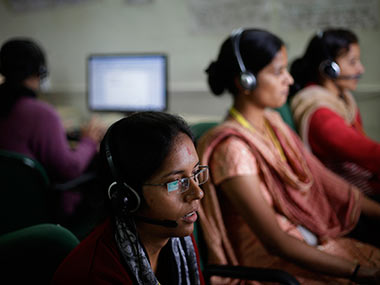 NEWS
NEWS
 NEWS
NEWS
 NEWS
NEWS
![]() Been shopping in Wal-Mart recently? Then you might find it unsettling to know that you were probably being watched, and not just by the security guards on the lookout for shoplifters.
Been shopping in Wal-Mart recently? Then you might find it unsettling to know that you were probably being watched, and not just by the security guards on the lookout for shoplifters.
As American companies’ voracious appetite for information on consumers continues to grow, they’re becoming more and more determined not to miss a trick, so much so that many have now reached the point where they have to outsource customer surveillance to firms in India.
Every single move you make – the items you buy, those that you stick back on the shelves, the aisles you walk down, and the displays that catch your attention – all of this will be recorded and then transmitted to Mu Sigma, a data analytics firm based in Bangalore, or companies like them.
You’re being spied upon, admits Mu Sigma’s CEO Dhiraj Rajaram.
The information “can be analyzed to determine propensity to purchase, what a customer’s intent, satisfaction, sentiment is,” he explains.
Customer surveillance is one of the better known aspects of big data, or the business of storing and analyzing unstructured data, before trying to apply this knowledge to business practices. The idea is that the more that data companies – especially retailers – have on their customers, the better positioned they’ll be to sell customers exactly what they want, improving their services and generating more profits into the bargain.
Big data is fast becoming one of the world’s hottest industries, and like many IT skills, companies are looking to save time and money by outsourcing this offshore in places like India.
Until recently of course, outsourcing such a mammoth task as big data analysis probably wouldn’t have been very practical, but the emergence of open-source and cloud computing software has changed the dynamics of the game by significantly reducing the cost and inefficiencies of storing such vast amounts of data.
According to The Times of India, another reason for India’s popularity is cultural – many Indian families place high value on an education in mathematics, which has resulted in India’s statisticians gaining an edge over competing countries. This claim is evidenced by the fact that a number of foreign companies are opening their own analytics centers in India, for example IBM’s center in Bangalore.
Another factor driving offshore big data analysis is the lack of skilled professionals in the US that are able to do the work at home. Indeed, one study estimates that by 2018 there will be a shortfall of around 190,000 data analysis professionals in the US, leading to the creation of an offshore industry that could be worth as much as $25 billion per year.
No doubt Indian companies will be rubbing their hands with glee at the thought of all that money pouring in, but even that figure could well be just the tip of the iceberg, as local reports suggest that homegrown demand for big data is also about to surge dramatically – a recent survey revealed that almost 72% of organizations in India claim they are ‘considering, planning or running’ big data projects.
The last word on this goes to Mu Sigma’s Dhiraj Rajaram, who forecasts a very bright future for India’s data analysts:
“The world is only going to change faster and faster and faster. There will be more data, more algorithms, more applications, more new technologies.”
Support our mission to keep content open and free by engaging with theCUBE community. Join theCUBE’s Alumni Trust Network, where technology leaders connect, share intelligence and create opportunities.
Founded by tech visionaries John Furrier and Dave Vellante, SiliconANGLE Media has built a dynamic ecosystem of industry-leading digital media brands that reach 15+ million elite tech professionals. Our new proprietary theCUBE AI Video Cloud is breaking ground in audience interaction, leveraging theCUBEai.com neural network to help technology companies make data-driven decisions and stay at the forefront of industry conversations.